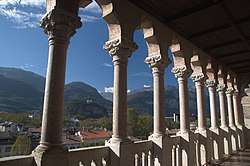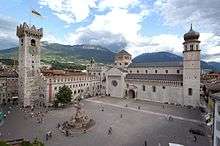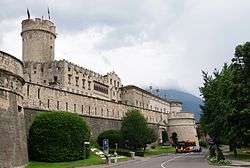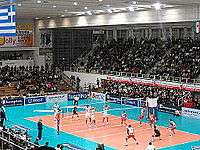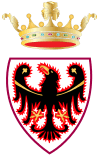Trento
| Trento | |||
|---|---|---|---|
| Comune | |||
| Comune di Trento | |||
 Panorama of Trento | |||
| |||
 Trento Location of Trento in Trentino-Alto Adige/Südtirol  Trento Trento (Italy) | |||
| Coordinates: 46°04′N 11°07′E / 46.067°N 11.117°ECoordinates: 46°04′N 11°07′E / 46.067°N 11.117°E | |||
| Country | Italy | ||
| Region | Trentino-Alto Adige/Südtirol | ||
| Province | Trentino (TN) | ||
| Frazioni | see list | ||
| Government | |||
| • Mayor | Alessandro Andreatta (PD) | ||
| Area | |||
| • Total | 157.9 km2 (61.0 sq mi) | ||
| Elevation | 194 m (636 ft) | ||
| Population (March, 2018) | |||
| • Total | 118,160 | ||
| • Density | 750/km2 (1,900/sq mi) | ||
| Demonym(s) | Trentini, Tridentini | ||
| Time zone | UTC+1 (CET) | ||
| • Summer (DST) | UTC+2 (CEST) | ||
| Postal code | 38121-38122-38123 | ||
| Dialing code | 0461 | ||
| Patron saint | Saint Vigilius | ||
| Saint day | June 26 | ||
| Website | Official website | ||
Trento [ˈtrɛnto] ![]()
Trento is an educational, scientific, financial and political centre in Trentino-Alto Adige/Südtirol, in Tyrol and Northern Italy in general. The University of Trento ranks 2nd among 'medium sized' Universities in the Census ranking[2] and 5th in the Il Sole 24 Ore ranking of Italian universities.[3] The city contains a picturesque Medieval and Renaissance historic centre, with ancient buildings such as Trento Cathedral and the Castello del Buonconsiglio.
Together with other Alpine towns Trento engages in the Alpine Town of the Year Association for the implementation of the Alpine Convention to achieve sustainable development in the Alpine Arc.
Trento was awarded the title of Alpine Town of the Year 2004.
The city often ranks highly among Italian cities for quality of life, standard of living, and business and job opportunities, being ranked 5th in 2017.[4] Trento is also one of the nation's wealthiest and most prosperous cities, with its province being one of the richest in Italy, although poorer than its neighbors Lombardy and South Tyrol, with a GDP per capita of €31,200 and a GDP (nominal) of €16.563 billion.[5]
Geography
The township of Trento encompasses the city centre as well as many suburbs of extremely varied geographical and population conditions (from the industrial suburb of Gardolo, just north of the city, to tiny mountain hamlets on Monte Bondone). Various distinctive suburbs still retain their traditional identity of rural or mountain villages.
Trento lies in a wide glacial valley known as the Adige valley, just south of the Dolomite Mountains, where the Fersina River and Avisio rivers join the Adige River (the second longest river in Italy). River Adige is one of the three primary south-flowing Alpine rivers; its broadly curving course alongside Trento was straightened in 1850.[6] The valley is surrounded by mountains, including Vigolana (2,150 m (7,050 ft)), Monte Bondone (2,181 m (7,156 ft)), Paganella (2,124 m (6,969 ft)), Marzola (1,747 m (5,732 ft)) and Monte Calisio (1,096 m (3,596 ft)). Nearby lakes include Lake Caldonazzo, Lake Levico, Lake Garda and Lake Toblino.
Frazioni
Frazioni, or subdivisions of Trento:
- Povo
- Villazzano
- Gardolo
- Roncafort
- Mattarello
- Martignano
- Cognola
- Ravina
- Romagnano
- Montevaccino
- Vela
- Meano
- Sardagna
- Sopramonte
- Vigo Meano
- Cortesano
- Gazzadina
- Candriai
- Vaneze
- Cadine
- Vigolo Baselga
Demographics
In 2007, there were 112,637 people residing in Trento, of whom 48% were male and 52% were female. Minors (children ages 18 and younger) totalled 18.01 percent of the population compared to pensioners who number 19.37 percent. This compares with the Italian average of 18.06 percent (minors) and 19.94 percent (pensioners). The average age of Trento residents is 41 compared to the Italian average of 42. In the five years between 2002 and 2007, the population of Trento grew by 5.72 percent, while Italy as a whole grew by 3.56 percent.[7] The current birth rate of Trento is 9.61 births per 1,000 inhabitants compared to the Italian average of 9.45 births.
As of 2006, 92.68% of the population was Italian. The largest immigrant group came from other European countries (mostly Albania, Romania): 4.13%, North Africa: 1.08%, and the Americas: 0.85%.
Trento Informa (a magazine distributed by the "comune") reports that in 2011 there were 117,190 people residing in Trento, of whom 48.5% aged between 45 and 65. The average age was 43.1 years. 13,535 (11.5%) were foreigners.[8]
History
The origins of this city on the river track to Bolzano and the low Alpine passes of Brenner and the Reschen Pass[9] over the Alps are disputed. Some scholars maintain it was a Rhaetian settlement: the Adige area was however influenced by neighbouring populations, including the (Adriatic) Veneti, the Etruscans and the Gauls (a Celtic people). According to other theories, the latter did instead found the city during the 4th century BC.
Trento was conquered by the Romans in the late 1st century BC, after several clashes with the Rhaetian tribes. Before the Romans, Trento was a Celtic village. In reality, the name derives from Trent, which is a tribute to the Celtic god of the waters (because of the river Adige). The Romans gave their settlement the name Tridentum and is a tribute to the Roman god Neptune (Tri Dentum, meaning 'Three Teeth' because of the three hills that surround the city: the Doss Trent, Sant'Agata and San Rocco). The Latin name is the source of the adjective "tridentine". On the old city hall, a Latin inscription is still visible: "Montes argentum mihi dant nomenque Tridentum" ("Mountains give me silver and the name of Trento"), attributed to Fra' Bartolomeo da Trento (died in 1251). Tridentum became an important stop on the Roman road that led from Verona to Innsbruck.[10]
After the fall of the Western Roman Empire, the independent bishopric of Trento was conquered by Ostrogoths, Byzantines, Lombards and Franks, finally becoming part of the Holy Roman Empire. In 1027, Emperor Conrad II created the Prince-Bishops of Trento, who wielded both temporal and religious powers. In the following centuries, however, the sovereignty was divided between the Bishopric of Trent and the County of Tyrol (from 1363 part of the Habsburg monarchy). Around 1200, Trento became a mining center of some significance: silver was mined from the Monte Calisio - Khalisperg, and Prince-Bishop Federico Wanga issued the first mining code of the alpine region.
In the 14th century, the region of Trento was part of Austria. The dukes of Austria (Habsburg Family) were also the counts of Tyrol and dominated the region for six centuries (1918).
A dark episode in the history of Trento was the Trento blood libel. When a 3-year-old Christian boy, Simonino, later known as Simon of Trent, disappeared in 1475 on the eve of Good Friday, the city's small Jewish community was accused of killing him and draining his blood for Jewish ritual purposes.[11] Eight Jews were tortured and burned at the stake, and their families forced to convert to Christianity. The bishop of Trento, Johannes Hinderbach, had Simonino canonized and published the first book printed in Trento, "Story of a Christian Child Murdered at Trento", embellished with 12 woodcuts.[11] In a governmental ceremony in the 1990s, Trento apologized to the Jewish community for this dark episode and unveiled a plaque commemorating the formal apology.

In the 16th century, Trento became notable for the Council of Trent (1545–1563) which gave rise to the Counter-Reformation. The adjective Tridentine (as in "Tridentine Mass") literally means pertaining to Trento, but can also refer to that specific event. Among the notable prince-bishops of this time were Bernardo Clesio (who governed the city from 1514 to 1539, and managed to steer the Council to Trento) and Cristoforo Madruzzo (who governed from 1539 to 1567), both able European politicians and Renaissance humanists, who greatly expanded and embellished the city.
During this period, and as an expression of this Humanism, Trento was also known as the site of a Jewish printing press. In 1558 Cardinal Madruzzo granted the privilege of printing Hebrew books to Joseph Ottolengo, a German rabbi. The actual printer was Jacob Marcaria, a local physician; after his death in 1562, the activity of the press of Riva di Trento ceased. Altogether, 34 works were published in the period from 1558 to 1562, most of them bearing the coat of arms of Madruzzo.[13]
Prince-bishops governed Trento until the Napoleonic era, when it changed hands among various states. Under the reorganization of the Holy Roman Empire in 1802, the Bishopric was secularized and annexed to the Habsburg territories. The Treaty of Pressburg in 1805 ceded Trento to Bavaria, and the Treaty of Schönbrunn four years later gave it to Napoleon's Kingdom of Italy.
The population staged armed resistance to French domination. The resistance leader was Andreas Hofer. During his youth, he lived in Italian Tyrol, where he learned the Italian language. When Hofer recovered Trento for the Austrians (1809), he was welcomed with enthusiasm by the population of Trento. Approximately 4,000 Trentinian volunteers (Sìzzeri or Schützen) died in battle against the French and Bavarian troops. In 1810, Hofer was captured and brought to Mantua, and was shot by French soldiers on the express order of Napoleon.
With Napoleon's defeat in 1814, Trento was again annexed by the Habsburg Empire. Church government was finally extinguished, and Trento was henceforth governed by the secular administration of Tyrol. In the following decades, Trento experienced a modernization of administration and economy with the first railroad in the Adige valley opening in 1859. The entire Mediterranean basin was at risk of malaria, a factor that affected the entire Italian peninsula and this Alpine region was not spared. Even Tuscany was particularly hard hit; malaria existed far inland into the Veneto area, reaching the Italian Alps.[14] From 1918 to 1940, government figures show Italy's malaria deaths decreased by 96%, due to the efforts of the Rockefeller Foundation and Italy's own malaria experts, who themselves were international leaders in malariology.[15]
During the late 19th century, Trento and Trieste, cities with ethnic Italian majorities still belonging to the Austrians, became icons of the Italian irredentist movement. Benito Mussolini briefly joined the staff of a local newspaper in 1909, but left Trento because they could not create an anti-Austrian group. There was dissatisfaction with the lack of provincial autonomy and the failure to establish a university for the region. Feelings of loyalty were focused on the 'father-figure' emperor, not for Austria.

The nationalist cause led Italy into World War I. Damiano Chiesa and the deputy in the Austrian parliament Cesare Battisti were two well-known local irredentists who had joined the Italian Army to fight against Austria-Hungary with the aim of bringing the territory of Trento into the new Kingdom of Italy. The two men were taken prisoners at the nearby southern front. They were put on trial for high treason and executed in the courtyard of Castello del Buonconsiglio.
The region was greatly affected during the war, and some of its fiercest battles were fought on the surrounding mountains in the southernmost regions and the southeast. Of a population of just less than 400,000 in the province, 55,000 men served in the Imperial and Royal Army of whom 11,000 died. Most served on the Galician front. 700 served with the Italian Army. After World War I, Trento and its Italian-speaking province, along with Bolzano (Bozen) and the part of Tyrol that stretched south of the Alpine watershed (which was primarily German-speaking), were annexed by Italy.
In July 1943 Mussolini was removed as Prime Minister when the allies invaded Sicily. Italy surrendered to the Allies, and declared war on Germany. German troops promptly invaded northern Italy and the provinces of Trento, Belluno and South Tyrol became part of the Operation Zone of the Alpine Foothills, annexed to Germany. Some German-speakers wanted revenge upon Italian-speakers living in the area, but were mostly prevented by the occupying German troops, who still considered Mussolini head of the Italian Social Republic and wanted to preserve good relations with the Italians. From November 1944 to April 1945, Trento was bombed as part of the so-called "Battle of the Brenner". War supplies from Germany to support the Gothic Line were for the most part routed through the rail line through the Brenner Pass. Over 6,849 sorties were flown over targets from Verona to the Brenner Pass, with 10,267 tons of bombs dropped. Parts of the city were hit by the Allied bombings, including the church of S. Maria Maggiore, the Church of the Annunciation and several bridges over the Adige river. In spite of the bombings, most of the medieval and renaissance city center was spared. It was finally liberated on 3 May 1945.
In 1947, Trento became the host of the Rally Stella Alpina.
Since the 1950s, the region has enjoyed prosperous growth, thanks in part to its special autonomy from the central Italian government.
On 4 August 2015, the cathedral tower caught fire by "spontaneous combustion". The clock stopped at 10:50 AM, a matter of minutes after the fire began.
Economy
The city owes much of its unique economy to its position along the main communication route between Italy and Northern Europe and to the Adige river which, prior to its diversion in the mid-19th century, ran through the center of the city. The Adige river was formerly a navigable river and one of the main commercial routes in the Alps. The original course of the river is now covered by the Via Torre Vanga, Via Torre Verde and the Via Alessandro Manzoni.

As late as World War II, Trento depended on wine-making and silk.[16] The manufacturing industry installed in the post-war period has been mostly dismantled. Today, Trento thrives on commerce, services, tourism, high-quality agriculture and food industry (including wine, fruit), as a research and conference center thanks to a small but renowned university and internationally renowned research centers such as Fondazione Bruno Kessler , active in both fundamental and applied research, the Italian-German Historical Institute, the Centre for Computational and Systems Biology and ECT* , active in theoretical nuclear studies and part of FBK, and as logistics and transportation thoroughfare.
Valued pink and white porphyry is still excavated from some surrounding areas (Pila). This stone can be seen in many of Trento's buildings, both new and old.
The city has two long-running annual sporting events: the Giro al Sas (a 10 km (6 mi) professional road running competition) was first held in the city in 1907 and continues to the present,[17] while the Giro del Trentino is an annual road cycling race which the city has hosted every year since 1963.[18]
Economy Festival Trento
The Economy festival (Festival dell’Economia di Trento) has been brought into being in 2006 in order to enable and facilitate discussions between economists and a broad public. The aim of this festival is to put the economic terminology across to everyone. The Festival dell’Economia di Trento takes place every year at the end of May on the historic Palazzi of the old town in Trento. Well known economists explain and interpret current economy issues, both from a economic-scientific as well as from a social and entrepreneurial viewpoint. In the course of the last years, numerous economy scholars and managers such as Sir Anthony Atkinson, Fan Gang, Zygmunt Bauman and the Nobel Prize winner Gary Becker took an active part in.[19]
Politics
Government
Trento is governed by the City Council of Trento. Voters elect directly 33 councilors and the Mayor of Trento every five years. The current Mayor of Trento is Alessandro Anreatta (PD), elected for the first time on 3 May 2009 (he served as acting mayor from 25 September 2008 to 3 May 2009) and re-elected in 2015.
This is a list of the mayors of Trento since 1945:
| Mayor | Term start | Term end | Party | |
|---|---|---|---|---|
| Luigi Battisti | 8 May 1945 | 21 September 1946 | PSI | |
| Tullio Odorizzi | 21 September 1946 | 19 October 1948 | DC | |
| Dino Ziglio | 19 October 1948 | 13 June 1951 | DC | |
| Nilo Piccoli | 13 June 1951 | 15 July 1964 | DC | |
| Edo Benedetti | 15 July 1964 | 14 January 1975 | DC | |
| Giorgio Tononi | 14 January 1975 | 16 June 1983 | DC | |
| Adriano Goio | 16 June 1983 | 15 June 1990 | DC | |
| Lorenzo Dellai | 15 June 1990 | 2 October 1998 | DC | |
| Alberto Pacher | 2 October 1998 | 25 September 2008 | DS | |
| Alessandro Andreatta | 25 September 2008 | incumbent | PD |
Euroregion Tyrol-South Tyrol-Trentino
In 1996, the European Union approved further cultural and economic integration between the Austrian province of Tyrol and the Italian autonomous provinces of South Tyrol and Trentino by recognizing the creation of the Euroregion Tyrol-South Tyrol-Trentino.
Main sights
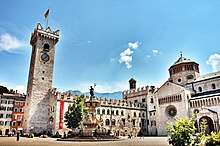
Although off the beaten path of mass tourism, Trento offers rather interesting monuments. Its architecture has a unique feel, with both Italian Renaissance and Germanic influences. The city center is small, and most Late-Medieval and Renaissance buildings have been restored to their original pastel colours and wooden balconies. Part of the medieval city walls is still visible in Piazza Fiera, along with a circular tower. Once, these walls encircled the entire city and were connected to the Castello del Buonconsiglio. The main monuments of the city include:
- Duomo (Cathedral of Saint Vigilius), a Romanesque-Gothic cathedral of the twelfth-thirteenth century, built on top of a late-Roman basilica (viewable in an underground crypt).
- Piazza Duomo, on the side of the cathedral, with frescoed Renaissance buildings and the Late Baroque Fountain of Neptune (Fontana di Nettuno) built in 1767–1768.
- Church of Santa Maria Maggiore (1520), site of the preparatory congregations of the Third Council of Trent (April 1562 – December 1563). It was built for Bishop Bernardo Clesio by the architect Antonio Medaglia in Renaissance-Gothic style. The façade has a notable 16th-century portal, while the interior has works by Giambettino Cignaroli and Moroni.
- Castello del Buonconsiglio (Buonconsiglio Castle), which includes a museum and the notable Torre dell'Aquila, with a cycle of fine Gothic frescoes depicting the months, commissioned by the prince-bishop Georg von Lichtenstein.
- Church of San Pietro (12th century) It has a neo-Gothic façade added in 1848–1850.
- Church of Sant'Apollinare, erected in the 13th century at the feet of the Doss Trento hill.
- Church of San Lorenzo (12th century). It has a Romanesque apse.
- Torre Verde (Green Tower), along the former transit path of the Adige river, is said to be where persons executed in the name of the Prince-Bishop were deposited in the river.
- Palazzo delle Albere (Palace of the Trees), a Renaissance villa next to the Adige river built around 1550 by the Madruzzo family, now hosting a modern art museum.
- Palazzo Pretorio, next to the Duomo, of the 12th century, with a bell tower (Torre Civica) of the thirteenth century (it now hosts a collection of baroque paintings of religious themes). It was the main Bishops' residence until the mid-13th century.
- Palazzo Salvadori (1515).
- Palazzo Geremia (late 15th century). It has a Renaissance exterior and Gothic interiors.
- Palazzo Lodron, built during the Council of Trent. The interior has a large fresco cycle.
- Various underground remains of the streets and villas of the Roman city (in Via Prepositura and Piazza Cesare Battisti).
Trento also sports modernist architecture, including the train station and the central post office, both by rationalist architect Angiolo Mazzoni. In particular, the train station (1934–36) is considered a landmark building of Italian railways architecture and combines many varieties of local stone with the most advanced building materials of the time: glass, reinforced concrete, metal. The post office was once decorated with colored windows by Fortunato Depero, but these were destroyed during bombings in World War II. Other buildings of that time include the Grand Hotel (by G. Lorenzi) with some guest rooms furnished with futurist furniture by Depero, and the "R. Sanzio" Primary School built in 1931–34 and designed by Adalberto Libera.
Gallery
 MUSE
MUSE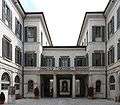 Palazzo Thun
Palazzo Thun Piazza Fiera
Piazza Fiera- Palazzo Vescovo
 Casa Cazuffi
Casa Cazuffi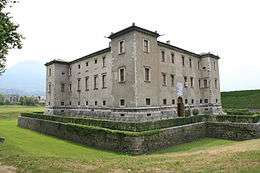
 Chiesa San Francesco Saverio
Chiesa San Francesco Saverio
Culture
Museums
- MUSE - Museo delle Scienze, is a museum of science and natural history museum. The museum was planned by Renzo Piano and opened in 2013.
- Municipal Gallery, is part of the Museum of Modern and Contemporary Art of Trento and Rovereto - MART
- Regional Museum of Art, is in the Castello del Buonconsiglio, the former seat of the Prince-Bishops of Trento
- The Tridentine Diocesan Museum, is located in the Palazzo Pretorio, next to the Cathedral Square of Trento, and shows the artistic treasures of the diocese of Trento as well as the influence of the council on the city.
- Viote Alpine Botanical Garden; Trento's surroundings are known for the mountain landscapes, and are the destination of both summer and winter tourism. The Alpine Botanical Garden, located on Monte Bondone in Le Viote, was founded in 1938.
- Museo dell'Aeronautica Gianni Caproni, is an aeronautical museum and located in Mattarello, near Trento Airport.
Theatre
- Teatro Sociale - was realized in 1819
- Teatro Auditorium
- Teatro San Marco
- Teatro di Meano - located in the fraction Meano
Cultural Events
- Economy Festival Trento
- Christmas Market Trento
- Mountain Film Fesitval; Trento is also the venue of a Mountain Film Festival.
Education
University of Trento

The University of Trento was founded in 1962 and has its headquarters in the city of Trento. The other university location is in Rovereto. In total, over 16,000 students study in Trento. Through the Euroregion Tyrol-South Tyrol-Trentino, the university also works closely together with the universities of Innsbruck and Bolzano. The University of Trento has the following faculties:
|
|
Notable people
Notable people born in or associated with Trento include:
- Alcide De Gasperi, 30th Prime Minister of Italy and one of the founding fathers of the European Union
- Cesare Battisti, Italian patriot during the Italian irredentism
- Jacob Acontius, Italian priest
- Giacomo Aconzio, friar in the Order of the Hermits of St Augustine
- Beniamino Andreatta, politician
- Lorenzo Bernardi, volleyball player for the Italian national team who was declared "player of the century" by an international jury
- Francesco Antonio Bonporti, composer
- Aliprando Caprioli, 16th-century engraver
- Ernst von Koerber, prominent politician of Austria-Hungary
- Chiara Lubich, founder of the Focolare Movement
- Martino Martini, geographer, historian, missionary
- Francesca Neri, award-winning actress
- Paolo Oss Mazzurana, Trento's most notable mayor. His tenure is characterized by progressive economic policies that impacted Trento's commercial sector and its eventual independence.
- Antonio Pedrotti, conductor and composer
- Andrea Pozzo, Jesuit Brother, baroque painter and architect
- Renzo Videsott, Italian alpinist and conservationist
- Alessandro Vittoria, mannerist sculptor
- Hermann Zingerle, neuropathologist
Transport
The A22-E45 highway connects Trento to Verona and to Bolzano, Innsbruck and Munich.
Trento railway station, opened in 1859, forms part of the Brenner railway (Verona–Innsbruck), which is the main rail connection between Italy and Germany. The station is also a junction with the Valsugana railway, which connects Trento to Venice. Trento has several other railway stations, including Trento FTM railway station, terminus of the Trento-Malè-Marilleva railway (FTM).
Bus or train services operate to the main surrounding valleys: Fassa, Fiemme, Gudicarie, Non, Primiero, Rendena, Sole, Tesino, Valsugana.
The public transport network within the city consists of 20 bus lines operated by Trentino Trasporti and a funicular service to Sardagna. The various railway stations within Trento's city limits are integrated into the public transport network.
 Trento Airport
Trento Airport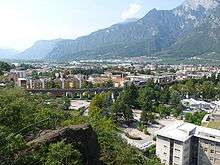 Valsugana railway
Valsugana railway
Sport
Local Teams
- Trentino Volley, one of the top teams in Italian volleyball, has won the Italian championship four times, three times the CEV Champions League title and four times the club world cup.
- Aquila Basket Trento, has been playing regularly in the highest Italian basketball league for several years and reached the final of the play-offs in the 2016/17 season and 2017/18 season.
- AC Trento SCSD has been one of the most traditional football clubs in the region of Trentino Alto Adige since its foundation in 1921. Currently, the club plays in the fourth highest Italian league, the Serie D.
Sports Venue
- PalaTrento, it was opened in 2000 and is an indoor arena with a capicity of 4300 seats. Trentino Volley and Aquila Basket Trento play their respective games there.
- Stadio Briamasco, is a football stadium with a capacity of 4277 seats and is currently the home stadium of AC Trento.
International relations
Twin towns – Sister cities
Trento is twinned with:






Districts of Trento are twinned with:
Partner cities
See also
References
Notes
- ↑ "Trento | Italy | Encyclopædia Britannica". britannica.com. Retrieved 2016-11-20.
- ↑ "Classifica Censis 2017". Censis. Retrieved 2017-08-02.
- ↑ "Le pagelle alle università". Il Sole 24 Ore. Retrieved 2010-07-07.
- ↑ "Qualità della vita". Il Sole 24 ORE. Retrieved 2018-02-07.
- ↑ GDP per capita in the EU in 2011: seven capital regions among the ten most prosperous
- ↑ Taylor 1940:215, 224.
- ↑ "Statistiche demografiche ISTAT". Demo.istat.it. Retrieved 2010-04-22.
- ↑ Trento Informa June 2012 Archived 18 February 2013 at Archive.is
- ↑ Griffith Taylor, "Trento to the Reschen Pass: A Cultural Traverse of the Adige Corridor", Geographical Review 30.2 (April 1940:215-237), "The site and evolution of the town of Trento", pp 220-.
- ↑ Taylor 1940:221.
- 1 2 "The New York Times - Breaking News, World News & Multimedia". iht.com. Retrieved 2016-11-20.
- ↑ The 16th-century original is Taylor 1940, fig. 6 p. 222.
- ↑ "Riva Di Trento:". JewishEncyclopedia.com. Retrieved 2010-04-22.
- ↑ Majori G (2012). "Short history of malaria and its eradication in Italy with short notes on the fight against the infection in the mediterranean basin". Mediterr J Hematol Infect Dis. 4: e2012016. doi:10.4084/MJHID.2012.016. PMC 3340992. PMID 22550561.
- ↑ http://rockarch.org/publications/resrep/hall.pdf
- ↑ Taylor 40:224.
- ↑ Un balzo nel passato Archived 22 July 2011 at the Wayback Machine. (in Italian). Giro al Sas. Retrieved 2010-11-03.
- ↑ Albo d’oro dal 1962 al 2009. Giro al Trentino. Retrieved 2010-11-03.
- ↑ "Economy Festival Trento". trentino.com. Retrieved 2017-12-02.
Further reading
- David Kay (1880), "Principal Towns: Trent", Austria-Hungary, Foreign Countries and British Colonies, London: Sampson Low, Marston, Searle, & Rivington
- T. Francis Bumpus (1900), "Trent", The Cathedrals and Churches of Northern Italy, London: Laurie
External links
| Wikimedia Commons has media related to Trento. |
| Wikivoyage has a travel guide for Trento. |
- Official homepage of Trento
- Azienda per il Turismo Trento e Monte Bondone
- Flak Guns In The Brenner Pass
- Wiki of Trento
- Weather Station and Webcams Live
- Trento Bus and Train (Android App)
- ViaggiaTrento(Android Application) -- Implemented as part of SmartCampus project, the research project founded by TrentoRise, UNITN, and FBK

